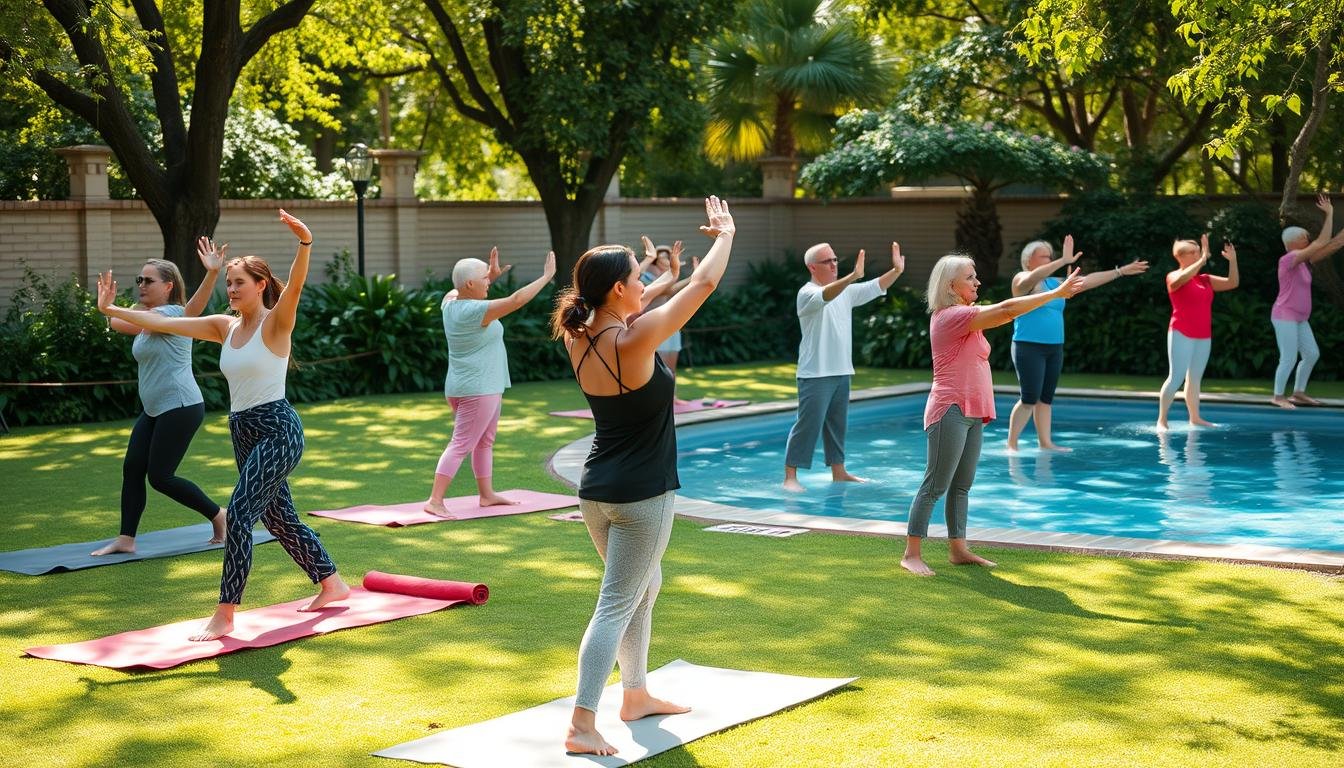The preservation of joint health is paramount, a necessity that escalates with age or the onset of arthritis. Low-impact exercises are pivotal in safeguarding joints, alleviating pain, and augmenting mobility without undue strain. These mild, joint-conducive workouts fortify the muscles encasing the joints, elevate bone density, augment vitality, and elevate overall health.
Consistent physical engagement profoundly influences the management of joint pain and stiffness. Activities that minimize joint pressure, such as ambulation, aquatic exercises, and cycling, can mitigate arthritis symptoms and facilitate everyday movements. By integrating diverse low-impact activities into your regimen, you can maintain an active lifestyle while prioritizing joint health.
Initiating any exercise regimen necessitates a consultation with a healthcare professional or physical therapist. They will craft a tailored, secure plan that addresses your unique requirements and conditions, ensuring safe exercise practices. Collaborating with your healthcare team enables the identification of optimal low-impact exercises, facilitating continued mobility and flourishing.
Understanding Joint Health and Pain Management
Joint pain can stem from a multitude of conditions, including osteoarthritis, rheumatoid arthritis, and bursitis. Osteoarthritis manifests when the cartilage enveloping the bone’s ends deteriorates, precipitating pain, stiffness, and diminished mobility. In contrast, rheumatoid arthritis is an autoimmune disorder that impairs the joint lining, inducing inflammation and structural damage. Bursitis, characterized by inflammation of the fluid-filled sacs, known as bursae, which cushion and lubricate the joints, also contributes to joint discomfort.
Common Causes of Joint Pain
Joint pain can arise from various sources, including age-related degeneration and injuries, as well as underlying medical conditions. Osteoarthritis and rheumatoid arthritis, two prevalent forms of arthritis, can significantly impair joint function and induce pain. Bursitis, marked by inflammation of the fluid-filled sacs that cushion the joints, also exacerbates joint discomfort.
The Role of Movement in Joint Health
Engagement in regular physical activity is paramount for preserving joint health. Physical activity fosters flexibility, strength, and range of motion, all critical for averting and managing joint pain. Research indicates that moderate exercise, such as a 20-minute treadmill session, can elicit a measurable anti-inflammatory response, thus mitigating joint pain and stiffness.
Risk Factors and Prevention Strategies
Several factors can elevate the risk of joint-related issues, including age, genetics, previous injuries, and excess weight. Maintaining a healthy weight is crucial, as each pound lost can reduce knee pressure by 4 pounds. Practicing good posture and participating in low-impact activities like walking, cycling, and strength training can prevent joint problems and alleviate existing pain.
| Risk Factor | Prevention Strategy |
|---|---|
| Age | Engage in regular low-impact exercise |
| Genetics | Maintain a healthy weight |
| Previous Injuries | Practice good posture |
| Excess Weight | Incorporate strength training exercises |
Benefits of Low-Impact Exercises for Joint Health
Engagement in low-impact exercises yields manifold advantages for joint health. Activities such as walking, swimming, and cycling, by virtue of their low-impact nature, mitigate joint stress while delivering efficacious cardiovascular benefits. This approach minimizes joint impact, facilitating weight management, a critical factor in mitigating joint pain and preventing further deterioration.
Consistent participation in low-impact exercises has been correlated with a 20% diminished risk of developing arthritis-related joint afflictions compared to those leading sedentary lifestyles. Such exercises foster muscle strength, augment flexibility, and enhance range of motion, all pivotal for optimal joint function and pain reduction. Further, activities like elliptical training and stair machines can incinerate up to 400 calories within a 30-minute interval, contributing to weight management and cardiovascular health enhancement.
Swimming and other aquatic exercises notably decrease joint pain and stiffness by up to 10% due to their inherently low-impact characteristics. Strength training, capable of increasing bone density by 15% over 6 months, is indispensable for joint health preservation. Tai chi, emphasizing balance and stability, has been found to diminish the risk of falls by 45% in the elderly, underscoring the protective benefits of low-impact exercises for joints.
The benefits of low-impact exercises transcend mere physical health, with a 15% enhancement in mental health scores among participants. By fortifying the muscles encircling the joints, supporting cartilage lubrication, and enhancing flexibility and stability, these activities present a comprehensive strategy for joint health maintenance and life quality enhancement.
Essential Water-Based Activities for Joint Protection
Water-based exercises emerge as a premier method for maintaining joint health and mitigating pain. The water’s buoyancy significantly diminishes the impact on joints, facilitating a range of low-impact activities. These activities are instrumental in strengthening muscles, enhancing flexibility, and optimizing joint function.
Swimming Techniques for Joint Health
Swimming stands out as a comprehensive full-body workout, profoundly beneficial for joint health. Engaging in various swimming strokes targets and fortifies diverse muscle groups without excessive stress on joints. The low-impact freestyle, along with the joint-friendly backstroke and breaststroke, renders swimming a versatile and effective means to maintain activity while safeguarding joints.
Water Aerobics Routines
Water aerobics present a spectrum of low-impact exercises that challenge the body while minimizing joint stress. Activities like aqua jogging, water walking, and standing water push-ups constitute a gentle resistance training regimen. This regimen enhances cardiovascular fitness, muscle strength, and joint stability.
Pool Walking and Resistance Training
The pool environment is ideal for low-impact exercises such as pool walking and resistance training. Pool walking fortifies lower body strength and balance without the risks associated with high-impact activities. Resistance training exercises, leveraging the water’s resistance, bolster muscle strength and support joint function.
These aquatic activities are notably advantageous for individuals with arthritis or other joint-related conditions. They offer a pain-free avenue to remain active and enhance joint health. Incorporating a variety of aquatic exercises into your regimen allows you to reap the benefits of low-impact movement while protecting your joints from further strain or injury.
Land-Based Low-Impact Exercises for Joint Health
Engaging in land-based low-impact exercises is a pivotal strategy for enhancing joint health and overall fitness. Walking, including the practice of Nordic walking with poles, serves as a straightforward yet impactful activity. It significantly boosts cardiovascular health and joint flexibility. Cycling, whether performed outdoors or on a stationary bike, fortifies leg muscles without exacerbating joint stress. Resistance training, utilizing bands, light weights, or bodyweight exercises, further aids in joint support and protection.
For individuals with restricted mobility, chair exercises present modified alternatives to bolster strength and circulation. These exercises can seamlessly integrate into daily routines, accommodating diverse fitness levels. By participating in low-impact exercises, one can sustain joint health, diminish injury risk, and foster overall well-being.
Integrating a range of land-based low-impact exercises, such as walking for joint health, cycling, and strength training for joints, facilitates sustained activity and pain mitigation. Chair exercises, on the other hand, offer a joint-friendly workout option for those with mobility constraints. By emphasizing low-impact activities, individuals can derive the advantages of physical fitness while safeguarding their joints.





